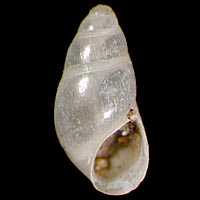|
< Previous family introduction |
|
|||||
 |
Family Iravadiidae Iravadiids
|
|||||
|
Iravadiids are small estuarine and marine molluscs that have a narrow or moderately wide conical shell with a smooth, depressed protoconch. The family occurs almost worldwide but most species are found in the Indo-West Pacific. There are 15 species recognised from Australia, most with a tropical Indo-West Pacific distribution. Two of these are abundant in tropical mangroves in Australia. Only two species occur in NSW. The present understanding of the Iravadiidae is based on the work of Ponder (1984). On the basis of anatomy and radula structure, he included in the family genera that had previously been placed in six other families. The family is related to the Rissoidae, where some of the species were previously placed, but is more closely related to the Hydrobiidae. The anatomical features that distinguish it are within the reproductive system: " .. a slit-like ventral opening to the pallial genital duct in the female. The bursal duct and, with one exception, the bursa copulatrix, is entirely in the pallial part of the genital tract" (Ponder, 1984). He also showed the family to have a "wide range of shell, radular and opercular forms". Most iravadiids live partially buried in mud or sediment and probably feed on decaying organic matter or bacteria. Most species live in brackish water, particularly in mangroves, but a few are fully marine in the lower littoral or sub-littoral zones. The two NSW species are marine, occurring in estuaries and bays. Thee literature on the Australian Iravadiidae is sparse and scattered. Prior to Ponder's 1984 revision, the species were often treated in the Rissoidae. Laseron described one of the two NSW species in his 1950 revision of the Rissoidae. Family Reference Ponder, W.F. 1984. A review of the genera of the Iravadiidae (Gastropoda, Rissoacea) with an assessment of the relationships of the family Malacologia 25: 21-71 Coverage Only two species of this family are recorded from NSW, both of which are detailed here. Identification notes Shell form in the Iravadiidae overlaps that of other micromollusc families, and is variable within the family. The shell is most often smooth, but may also be spirally ribbed, axially ribbed or both. The most useful shell character in placing species into the family is the protoconch - low or even flat, of about two smooth whorls, with the first whorl minute. |